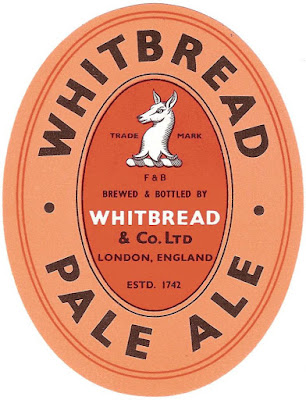I’ve loads more information on these than on the draught beers. See if you can spot what’s unusual about their bottled range:
“Tennant's bottled beers were: Lion Pale Ale - a fine pale ale, Lion Brown Ale - enjoyed by older drinkers, Glucose Stout - a beautiful sweet stout, No.1 Barley Wine - an old fashioned drink and Gold Label Barley Wine — a pale, sparkling barley wine, about which I will elaborate later. Gold Label (together with Lion Pale Ale) had been awarded the 'Prix D'Excellence 1958' in Belgium, which was one of the most important brewing countries in the world at that time. Tennant's proudly displayed the words 'Prix D'Excellence' on street posters advertising the barley wine. However, due to a certain lack of familiarity with the pronunciation of the French language in those days, the drink was perceived, in some circles as a forerunner of viagra, which did no harm at all to its rocketing sales.”
"The Brewer's Tale" by Frank Priestley, 2010, page 11.
They brewed two Barley Wines, which seems slightly excessive. And, most confusingly, both were called No. 1. There was the older beer which named No. 1 Barley Wine and the 1950’s introduction Gold Label No. 1 Sparkling Barley Wine.
Let’s take a look:
| Tennant bottled beers 1950 - 1959 | ||||||||
| Year | Beer | Style | Price per pint d | OG | FG | ABV | App. Atten-uation | colour |
| 1954 | Gold Label | Barley Wine | 60 | 1101.5 | 1021 | 10.60 | 79.21% | 90 |
| 1955 | Gold Label | Barley Wine | 57 | 1102.4 | 1021 | 10.77 | 79.69% | 45 |
| 1958 | Gold Label | Barley Wine | 57 | 1102.5 | 1018 | 10.58 | 82.54% | 35 |
| 1955 | No. 1 Barley Wine | Barley Wine | 57 | 1097.5 | 1023 | 9.84 | 76.82% | 175 |
| 1952 | Brown Ale | Brown Ale | 20 | 1032.5 | 1012 | 2.62 | 62.46% | 100 |
| 1955 | Lion Brown Ale | Brown Ale | 23 | 1034.9 | 1011 | 3.04 | 67.34% | 85 |
| 1955 | Family Brown Ale | Brown Ale | 18 | 1031.9 | 1008 | 3.16 | 76.49% | 50 |
| 1955 | Light Dinner Ale | Light Ale | 18 | 1030.8 | 1007 | 3.10 | 77.60% | 23 |
| 1950 | Pale Ale | Pale Ale | 1039.4 | 1012 | 3.52 | 69.04% | 27 | |
| 1955 | Lion Pale Ale | Pale Ale | 27 | 1036.6 | 1010 | 3.46 | 72.95% | 23 |
| 1958 | Pale Ale | Pale Ale | 25 | 1031.4 | 1008 | 2.99 | 76.11% | 27 |
| 1955 | Malt Stout | Stout | 24 | 1036.2 | 1018 | 2.41 | 51.66% | 350 |
| 1956 | Glucose Stout | Stout | 26 | 1040.4 | 1021 | 2.49 | 48.02% | 225 |
| 1957 | Glucose Stout | Stout | 26 | 1038.3 | 1018 | 2.57 | 52.22% | 325 |
| 1959 | Glucose Stout | Stout | 25 | 1039.8 | 1019 | 2.70 | 52.76% | 225 |
| Source: | ||||||||
| Whitbread Gravity book held at the London Metropolitan Archives, document number LMA/4453/D/02/002. | ||||||||
Gold Label was an extremely important beer because it was the first pale Barley Wine. But if you look closely you’ll see that it didn’t start out pale. Well, only in comparison with Tennant’s other Barley Wine, which was almost as dark as a Stout. You can see that it got paler as the 1950’s progressed and by 1958 was approached the colour of Bitter. I won’t go into Gold Label in too much depth here because Priestley discusses its production method later in the book. I’ll be writing about that later. But it’s something I’m particularly pleased to have found.
It looks like Tennant discontinued some beers during the 1950’s: LDA (presumably a Light Ale), Malt Stout and Family Brown Ale.
Lion Brown Ale is quite strong compared to most of its rivals. Family Brown Ale has a more typical OG for a 1950’s Brown Ale. Though a low rate of attenuation means that it's only just over 3% ABV, which is less than Family Brown Ale.
Glucose Stout is pretty obviously a Sweet Stout. A very sweet Stout, given its 50% attenuation. The name is a slight hint it might be sweet. I’m still wondering why beers like this were so popular in the 1950’s. I guess they were just imitations of the very successful Mackeson.
My guess is that Lion Pale Ale is a bottled version of either Bitter or Best Bitter, probably the latter. Though it might just have been parti-gyled with the two Bitters. It should be possible to find out, as there are brewing records preserved in the Sheffield City Archives. Feel free to drop by and send me some photos, if you live in Sheffield.



























































































